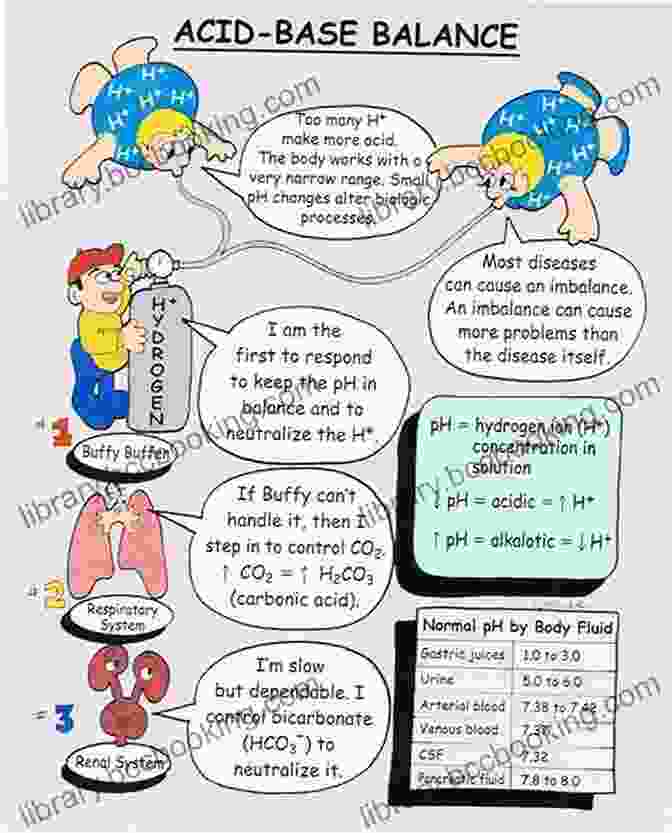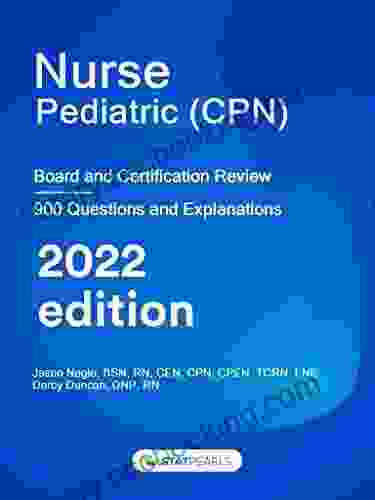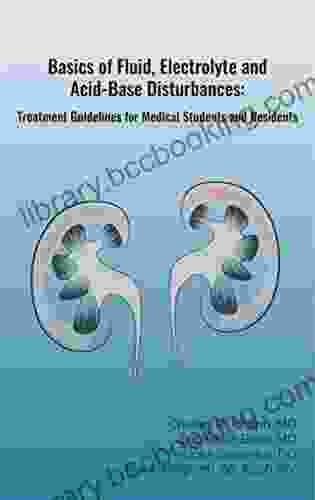Unlocking the Secrets of Fluid, Electrolyte, and Acid-Base Disturbances: A Journey into the Basics


Maintaining optimal fluid, electrolyte, and acid-base balance is crucial for the proper functioning of various bodily systems. Disturbances in these parameters can lead to a wide range of complications, including potentially life-threatening conditions. In this comprehensive treatise, we delve into the basics of fluid, electrolyte, and acid-base disturbances, providing healthcare professionals and students with an in-depth understanding of their mechanisms, clinical manifestations, and management strategies.
Understanding Fluid and Electrolyte Disturbances
Fluid and electrolyte balance plays a vital role in regulating cellular function, maintaining blood pressure, and ensuring proper tissue perfusion. Disturbances can occur due to alterations in fluid volume, electrolyte levels, or both.
5 out of 5
| Language | : | English |
| File size | : | 4448 KB |
| Text-to-Speech | : | Enabled |
| Screen Reader | : | Supported |
| Enhanced typesetting | : | Enabled |
| Print length | : | 133 pages |
Fluid volume disturbances are classified into volume depletion (dehydration) and volume overload (fluid retention). Dehydration occurs when fluid loss exceeds intake, leading to a decrease in extracellular fluid volume. This can result from conditions such as vomiting, diarrhea, or excessive sweating. Conversely, fluid retention occurs when fluid intake exceeds output, leading to an increase in extracellular fluid volume. This condition can be associated with heart failure, kidney dysfunction, or liver disease.
Electrolyte disturbances refer to changes in the levels of essential ions, such as sodium, potassium, calcium, chloride, and magnesium. These ions play crucial roles in maintaining electrical stability, nerve impulses, muscle contractions, and other physiological processes. Electrolyte imbalances can arise from a variety of factors, including dietary deficiencies, excessive loss through vomiting or diarrhea, or impaired kidney function.
Clinical Manifestations of Fluid and Electrolyte Disturbances
The clinical manifestations of fluid and electrolyte disturbances can be variable, depending on the type and severity of the disturbance. However, some common signs and symptoms include:
- Volume depletion: Dry mouth, thirst, decreased urine output, weakness, orthostatic hypotension
- Volume overload: Edema, shortness of breath, weight gain, elevated blood pressure
- Hyponatremia (low sodium): Fatigue, headache, nausea, seizures, coma
- Hypernatremia (high sodium): Thirst, dry skin, muscle weakness, seizures
- Hypokalemia (low potassium): Muscle weakness, fatigue, arrhythmias, ileus
- Hyperkalemia (high potassium): Muscle paralysis, arrhythmias, cardiac arrest
- Hypocalcemia (low calcium): Muscle cramps, tetany, seizures
- Hypercalcemia (high calcium): Nausea, vomiting, fatigue, bone pain
Acid-Base Disturbances
Acid-base balance refers to the body's ability to maintain a relatively constant pH level within a narrow range. Disturbances to this balance can occur when there is an excess or deficiency of either acid or base in the body fluids.
Acidosis refers to a condition in which the pH of body fluids decreases, indicating an excess of acid. This can result from conditions such as metabolic acidosis (e.g., diabetic ketoacidosis) or respiratory acidosis (e.g., chronic obstructive pulmonary disease).
Alkalosis refers to a condition in which the pH of body fluids increases, indicating an excess of base. This can result from conditions such as metabolic alkalosis (e.g., prolonged vomiting) or respiratory alkalosis (e.g., hyperventilation).
Clinical Manifestations of Acid-Base Disturbances
The clinical manifestations of acid-base disturbances can vary depending on the underlying cause and the severity of the disturbance. However, some common signs and symptoms include:
- Acidosis: Headache, confusion, nausea, vomiting, Kussmaul breathing
- Alkalosis: Muscle twitching, tetany, confusion, irritability
Management Strategies for Fluid, Electrolyte, and Acid-Base Disturbances
The management of fluid, electrolyte, and acid-base disturbances involves correcting the underlying cause and restoring the balance of the affected parameters.
Volume depletion is typically managed with intravenous fluid therapy to replenish lost fluids and electrolytes.
Volume overload is managed by restricting fluid intake and administering diuretics to promote diuresis.
Electrolyte disturbances are managed by administering electrolyte supplements or adjusting the intake of particular electrolytes in the diet.
Acidosis is managed by administering bicarbonate solutions to neutralize excess acid.
Alkalosis is managed by administering chloride solutions to neutralize excess base.
Maintaining optimal fluid, electrolyte, and acid-base balance is essential for overall health and well-being. Disturbances in these parameters can lead to a wide range of complications. Healthcare professionals must have a thorough understanding of the mechanisms, clinical manifestations, and management strategies of fluid, electrolyte, and acid-base disturbances to effectively care for patients and prevent adverse outcomes.
By providing a comprehensive overview of these disturbances, this article aims to empower healthcare professionals with the knowledge and skills necessary to effectively manage these conditions. Understanding the basics of fluid, electrolyte, and acid-base disturbances is crucial for ensuring optimal patient outcomes and improving overall healthcare practice.
5 out of 5
| Language | : | English |
| File size | : | 4448 KB |
| Text-to-Speech | : | Enabled |
| Screen Reader | : | Supported |
| Enhanced typesetting | : | Enabled |
| Print length | : | 133 pages |
Do you want to contribute by writing guest posts on this blog?
Please contact us and send us a resume of previous articles that you have written.
 Book
Book Novel
Novel Page
Page Chapter
Chapter Text
Text Story
Story Genre
Genre Reader
Reader Library
Library Paperback
Paperback E-book
E-book Magazine
Magazine Newspaper
Newspaper Paragraph
Paragraph Sentence
Sentence Bookmark
Bookmark Shelf
Shelf Glossary
Glossary Bibliography
Bibliography Foreword
Foreword Preface
Preface Synopsis
Synopsis Annotation
Annotation Footnote
Footnote Manuscript
Manuscript Scroll
Scroll Codex
Codex Tome
Tome Bestseller
Bestseller Classics
Classics Library card
Library card Narrative
Narrative Biography
Biography Autobiography
Autobiography Memoir
Memoir Reference
Reference Encyclopedia
Encyclopedia Mr Luna
Mr Luna Steven D Fleming
Steven D Fleming Nelson Mandela
Nelson Mandela Steve Solomon
Steve Solomon Valerie Hansen
Valerie Hansen R R Palmer
R R Palmer Louise Curtis
Louise Curtis Tara Neilson
Tara Neilson Parnaz Foroutan
Parnaz Foroutan Peter Hopkirk
Peter Hopkirk Michael Reyes
Michael Reyes Neil Goodwin
Neil Goodwin Kristy Burmeister
Kristy Burmeister Marcy Cottrell Houle
Marcy Cottrell Houle Richard Ayoade
Richard Ayoade Thomas F King
Thomas F King Naomi Hirahara
Naomi Hirahara Serena Gilbert
Serena Gilbert Robert Scheinfeld
Robert Scheinfeld Marcus J Borg
Marcus J Borg
Light bulbAdvertise smarter! Our strategic ad space ensures maximum exposure. Reserve your spot today!

 Vincent MitchellThe Revolutionary Way to Influence and Persuade: Unleashing the Secrets of...
Vincent MitchellThe Revolutionary Way to Influence and Persuade: Unleashing the Secrets of...
 Andy HayesThe Ultimate Guide to Passing the Nurse Pediatric CPN Board and Certification...
Andy HayesThe Ultimate Guide to Passing the Nurse Pediatric CPN Board and Certification... Xavier BellFollow ·15.1k
Xavier BellFollow ·15.1k Enrique BlairFollow ·17.3k
Enrique BlairFollow ·17.3k Brennan BlairFollow ·6.5k
Brennan BlairFollow ·6.5k Gerald ParkerFollow ·4.4k
Gerald ParkerFollow ·4.4k Terry PratchettFollow ·5.2k
Terry PratchettFollow ·5.2k Bob CooperFollow ·17.1k
Bob CooperFollow ·17.1k David BaldacciFollow ·3.4k
David BaldacciFollow ·3.4k Cody RussellFollow ·7k
Cody RussellFollow ·7k

 Brian Bell
Brian BellExploring The Natural World Through Mindful Expressive...
Unleash the...

 David Baldacci
David BaldacciJourney into the Enigmatic World of "Grass" by Sheri S....
Prepare to be captivated by "Grass," a...

 Dashawn Hayes
Dashawn HayesBusting Myths About Human Nature: Unraveling the Complex...
Challenging the...

 Ernest Hemingway
Ernest HemingwayNotes on Suicide: A Profound Exploration of the...
Suicide, a taboo subject shrouded in...
5 out of 5
| Language | : | English |
| File size | : | 4448 KB |
| Text-to-Speech | : | Enabled |
| Screen Reader | : | Supported |
| Enhanced typesetting | : | Enabled |
| Print length | : | 133 pages |












